


Try also Python!
An engineer, a physicist, a mathematician make a hike through the Scottish mountains. The engineer sees a black cow and shouts: "Look, in Scotland the cows are black!" The physicist improves it: "At least some cows are black." The mathematician: "At least one cow is black." Finally, the philosopher says, "At least we see, that one single cow is on one side what we call black."

Anleitung zum Denken
Ist Philosophie eigentlich zu erlernen? Kann man Philosophie vermitteln wie ein Handwerk oder etwas, wozu man einfach nur Übung braucht? Meiner Meinung nach kann man Philosophie erlernen aber nicht innerhalb einer bestimmten Frist, womit die Dauer des Studiums gemeint ist, sondern durch lebenslanges Lernen.Die Philosophie gehört nicht gerade zu den Disziplinen, die der Laie klar und deutlich vor Augen hat, wie die Tätigkeit eines Schreiners oder eines Polizisten. Philosophie wirkt auf die meisten Leute nebulös, schwadronierend oder nicht zuletzt nutzlos. Dabei hat dieses Fach auch sein handwerkliches Fundament. Und das ist nicht gerade klein. Es sind dies alle Wissenschaften und ganz besonders die formalen Wissenschaften wie die Logik, die Theologie und die Mathematik.
Aber eben auch Wissenschaften mit zumeist induktiven Methoden wie die Physik, die Biologie, Politik und Soziologie, wobei letztere zu den Geisteswissenschaften zählen. Die Geschichte der Philosophie ist hinlänglich bekannt. Dennoch möchte ich ein paar wenige Worte des Wiederholens wegen hierzu verlieren. Als die Menschen es leid waren, immer blind an die Willkür der Götter zu glauben, begannen sie selbst zu beobachten, nachzudenken und die Phänomene in Methoden zu fassen. Diese Leute waren Philosophen und diese Philosophen deckten oberflächlich alle damals bekannten Wissenschaften ab. Sie waren Physiker, Mathematiker und Soziologen sowie Juristen, Theologen etc.
Aufgrund der Fortschritte der Wissenschaften und der damit verbundenen Tiefe der Fächer ist das heute natürlich nicht mehr möglich. Dennoch stellt die Philosophie immer noch eine Oberbegrifflichkeit dar. Eine riesige Käseglocke, unter der die Spezialisten kleinteilig ihren Beitrag zum Großen und Ganzen leisten. Es kommt seit etwa 20 Jahren aber wieder häufiger vor, dass diese Spezialisten nach dem Sinn und Zweck ihrer Arbeit fragen, sich mit anderen Spezialisten interdisziplinär verknüpfen. Hier beginnt die Philosophie.
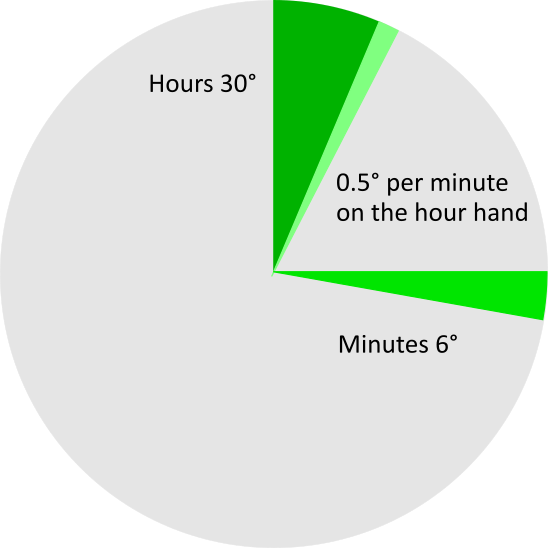
The angles of a clock!
What is the angle between the hour and minute hands at 5 o'clock and 52 minutes as an example? The problem is that the hour hand moves with the minute hand. Not as fast of course, but always a bit. As soon as about 30 minutes have passed, the hour hand is no longer where it was but has already wandered halfway to the next hour. But how much? And how many degrees after exactly 52 minutes?A circle is known to have 360° and it contains 12 hours. This results in 360°: 12h = 30° per hour. An hour consists of 60' and now results in a new ratio of 360° : 60' = 6 ° per minute. The hour hand thus moves at 30° per hour and the minute hand at 6 ° per minute. Small hint: 5 minutes · 6° are 30° so the same angle as the hour hand travels in an hour. How far does the hour hand move per minute?
The calculation is 360° : ( 12 · 60 ) = 0.5 ° per minute. So if 20 minutes pass, then the minute hand moves by 20' · 6° = 120° and the hour hand by 20' · 0.5° = 10°, and if it is about the included angle, then we'll subtract finally 120° - 10° = 110°
But wait a minute! Could it be like this concerning the reality? No, it can't. Due to the everlasting movement you'll never get any fixed angle at all. Imagine this as a photograph!
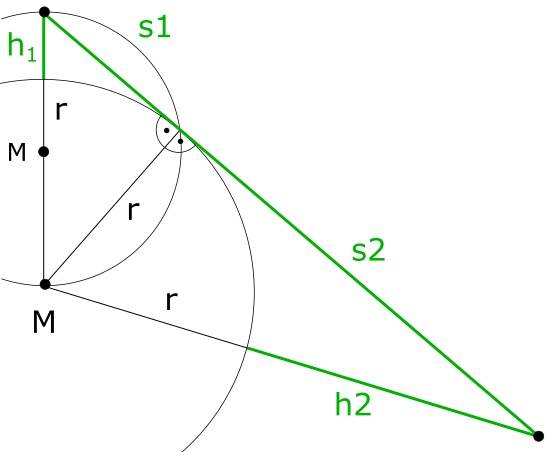
Maximale Sichtweite
Wenn Sie sich von einem Gegenstand entfernen, dann verschwindet er irgendwann optisch. Das liegt nicht nur am Sehvermögen des Betrachters oder am trüben Wetter, sondern auch an der Erdkrümmung. Tatsächlich wird die Erdkrümmung schon bei der Aussicht von einem hohen Turm sichtbar. Später verschwindet der Gegenstand sozusagen "hinter dem Horizont", was zwar poetisch aber nicht korrekt ist.
Diese schiebt sich dem Betrachter in den Weg und die gerade Sichtlinie wird unterbrochen. Bis es soweit ist, kann man aber mit zwei Pythagoräern schon berechnen, wie weit der Gegenstand sichtbar ist. Abhängig von der Höhe des Objekts und der Höhe des Betrachters, der vielleicht Ballon fährt.
Der Radius der Erde ist konstanter Teil der Hypothenuse und grob definiert mit 6370 Kilometern. Somit ergibt sich für die Hypothenuse r + h während die Kathete lediglich r ist. Beachten Sie aber, daß beide Dreiecke zusammen nicht rechtwinklig sind. Der Pythagoras gilt also immer nur für die Teildreiecke.
Im Skript sind die Eingaben auf 5 Stellen begrenzt und erfolgen in Metern! Somit ergibt sich eine maximale Höhe von 99999 Metern, was selbst bei einem Betrachter aus dem Flugzeug heraus ausreichend sein sollte.
Die Limitierung der Eingabe geschieht mittels Substring und die Anzahl der Ziffern muss zuvor natürlich mit einer for Routine gezählt werden. Interessiert an JavaScript? Klicken Sie einfach mit der rechten Maustaste auf die Website und wählen Sie "Seitenquelltext anzeigen". Funktioniert in allen gängigen Browsern. Das Skript wird oben im HTML Quelltext importiert und als Link zur Quelle dargestellt.

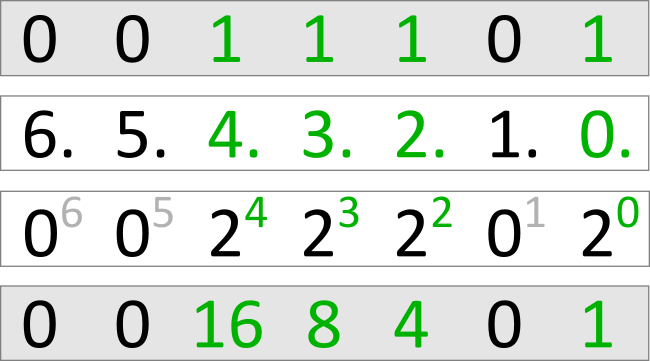
Binaries from zero to n
If you enter a binary code, the digits 0 and 1 are raised in order from right to left. At 5 digits, the exponents 4, 3, 2, 1 and 0 are based on 2. This only applies to the binary digits that are 1. In the case of a 0, the position is counted, but it has the result 0 because the base 0 high x returns 0 always.
From decimal input to binary output
So the opposite direction and a source code, which should explain what actually happens in the division. Note that it is always an integer division, or just the rest of that division. It is of course always divided by two, since the output is the binary number system. The binary number is nothing else but the middle column in opposite direction.
Definition of an array
Kind of repetition to understand what an array actually is. Want to say, nothing but a bar of signs. Important, not to get out of the bound. Therefore the condition using a while loop.
A multidimensional array
No big thing to understand what's going on using the different for loops which are nested. One for the rows and one for the cols. But compare also the different types of writing in C++ and Java.
Click "Start" to make the timer work. Click "Stop!" to write the current value into the array. If you click "Stop!" several times, the last value is accepted until five times. For reasons of clarity, the array only holds five values. Below the sum of the values and the average.
Changing datatypes
In the source code, the data type is changed from a string to an array concerning the size. It must be copied into an array and then you can also check if it's a character or a digit.
Sure, that was extensive. Mostly it's just about pulling the numbers out of the string and processing them. But can I count on the number or was it only recognized by the address? Bad news: "Array to Integer ( atoi )" does not work here.
A little smarter might be the source code by using Java. There's one single command which makes it easier to change between the string and array and instead of using the ordinary for-loop a foreach-loop is another shortcut. Never mind about the bound! This is defined by the loop named "for each" what means each character of the inputstring.
There are many topics in this source code, some of which have already been explained elsewhere. In essence, it is about the array, which actually only takes strings with which one could not calculate numerically. Hence the conversion of the data type to Double including rounding. The uncomplicated output via iterator should be striking. The effort in the counting routine was therefore worthwhile in the output.
Class and type
First you should keep in mind that every class or, better still, the variables it contains are declared as private by default. Nonetheless, we want to enter values that are processed according to the pattern. Therefore the variables of the blueprint are redefined. The class now works with this index. If there are different data types in a method, the designation "void" is necessary.
Select the digits
We just let the string be a string. If we have no reason to write in a string, we make it a little easier for ourselves and write in an array of characters. However, please note the parameter and the command, which of course differs. In addition, the conditions in the counting routine are now different.
How about the positions? We would like to know where the digits are. If you type into a string you'll miss the index. Change the string into an array! For me it is only about the digits though you can give out the letters in the same way. Very easy to give out the positions now.
Public or private?
The declaration types private or public are used to define from where variables or methods can be accessed. The type private is only valid within its class, while public can be accessed across classes. It is even possible to use the public method using the private variable of its class from another class accessing.
Vector and push
Instead of using a list or a structure, I would like to briefly introduce the vector here. If several values or entries are to be recorded, these must be saved. Of course, this happens within the counting routine with "push back". Also note the input method for the character string which allows blanks also.
Functions and Vectors
Functions can also accommodate vectors. However, when calling the function, be sure to specify the vectors as parameters. In the function you have the possibility to change the vectors. So the way the vector is recorded, it does not have to stay.
Modulo to the end
A class and function should no longer be a central topic here. It is about how the variables have to be reassigned as soon as there is a cyclical swap in the continuous calculation. Modulo as a calculation is not a one-time thing here, which of course would also be possible, but a procedure that only comes to an end with zero.

An exception, a list and a reversed string
Admittedly, there are a little many topics in this source code. But let's not be confused: at its core, it's about the treatment of the exception and the list, which, by the way, is not created when an exception occurs. Almost casually, the "catch" calls a class. And on this occasion, a string is converted into an array by means of "string-split" and output reversed.
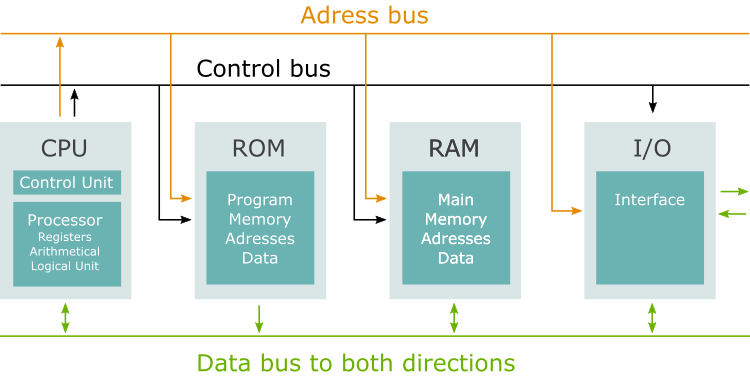
From bit to byte and the data rate
You can have the script calculated alternately from bit to byte or vice versa, depending on which field is empty. Then click on the button "Bits - Byte" to get the result in the still empty field. For the data rate, the clocking of the processor is necessary. The most common clocks are given here, based on usual bus widths.
Mental arithmetic
Mental arithmetic is fun. Once a two-digit factor is present, you should proceed distributively. However, this means that you have to remember the results in order to ultimately add them up. Of course, you can skip tasks or display the result. But then 10% of the success rate is deducted. Therefore: Take your time! There is no time limit and no time function in the background.





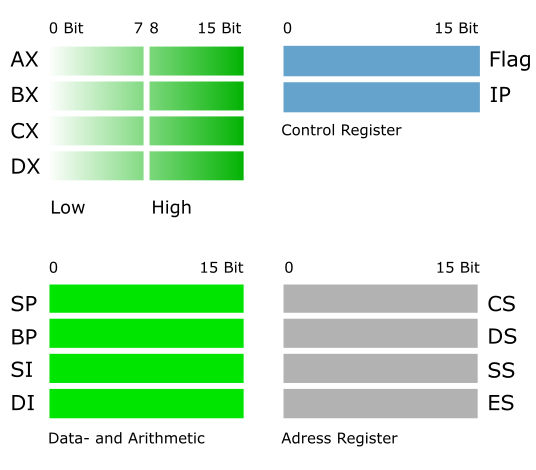
The registers
Assembler is a type of programming that dates back to the 1950s. At that time there were no high-level languages with routines and loops. Accordingly, computers performed only rudimentary tasks. One for today's terms simple if ... then ... instruction is not possible in an assembler-based manner. But counting operations with for loops. Assembler is all about registers. This means that you directly access the registry of the processor, which otherwise the compiler takes over. The registers are divided into four sections. There are thus 4 registers with 16 bits each. The high range of data registers is not always addressed and is optional. The abbreviations are for better orientation and are a general agreement.
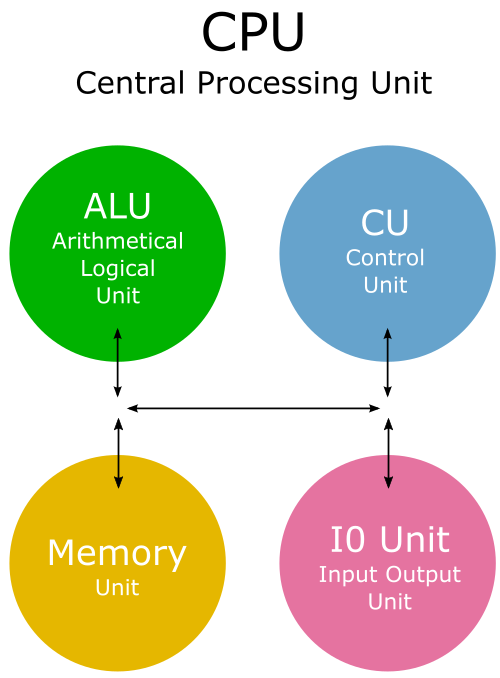
The components
The conductor of the orchestra is the controller. It controls the exchange of data between the processor and the main memory. This includes permanently updating and redistributing the stored data. But as soon as you program, you will be interested in the ALU. As the name suggests, this consists of a mathematical and a logical element, which together is called the core. Today, computers are produced including many cores.
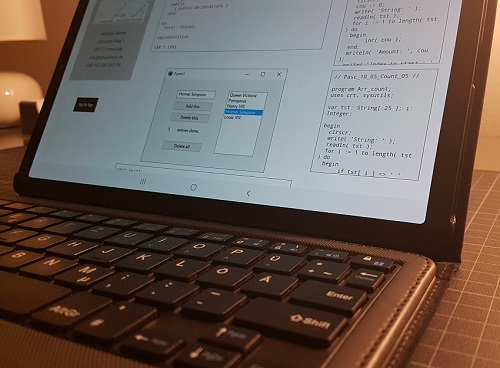
Ein wahrhaft schöner Zeitvertreib
ist das Schreiben und ich bleib
ihm wohl immer irgendwie verbunden,
denn in ruhigen, kreativen Stunden
regt's mich stark zum Denken an
über dies und das und irgendwann
auch über's eig'ne Tun und Treiben.
Darum werd' ich weiter schreiben.
Lyrics: Mathias Bleher 2019

